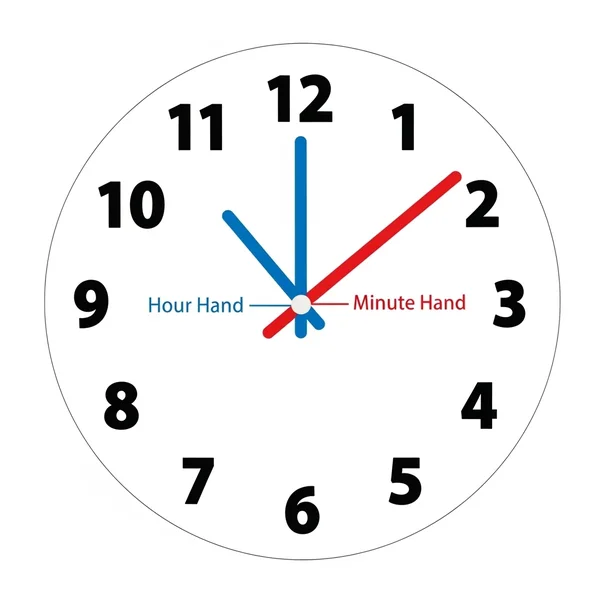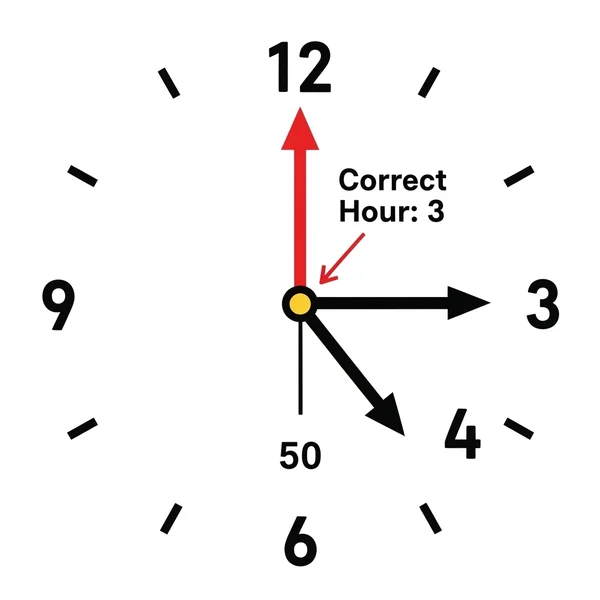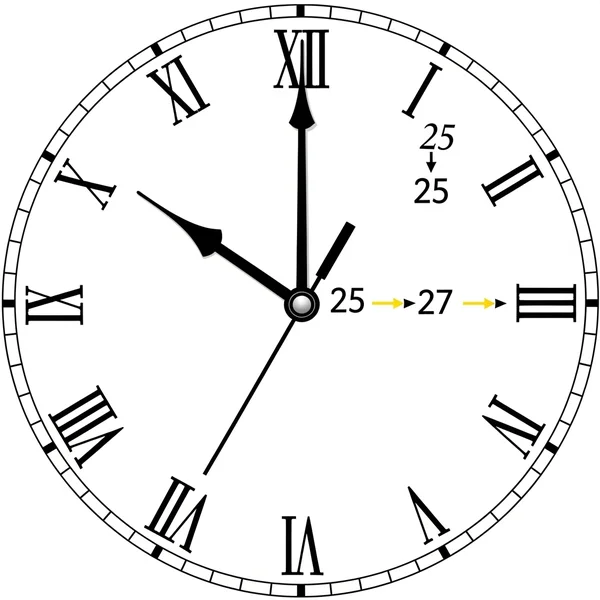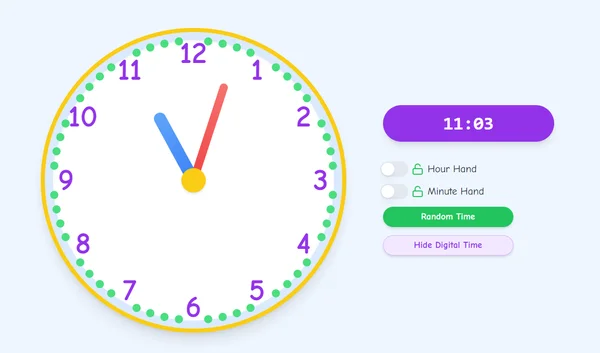Common Analog Clock Mistakes & How to Fix Them
Learning to read an analog clock is a significant milestone for children, but it often comes with a few bumps along the road. Many kids (and even some adults!) encounter common analog clock mistakes that can lead to frustration. Why is reading an analog clock hard for some? Don't worry, these hurdles are entirely normal! This guide is here to help parents and teachers spot and solve these common reading clock errors, making the journey to mastering time-telling smoother and more enjoyable. With a bit of understanding and the right tools, like our interactive clock, you can easily fix time telling issues.
Mistake 1: Mixing Up the Hour Hand and Minute Hand – A Common Analog Clock Hurdle
One of the most frequent analog clock mistakes is confusing the hour hand and the minute hand. Why does my child keep confusing the hour and minute hands on an analog clock? It's understandable, as both hands are constantly moving on the analog clock face.
Identifying the Short Hand (Hour) vs. The Long Hand (Minute)
The key difference lies in their length: the hour hand is shorter, and the minute hand is longer. Reinforce this visual distinction regularly. This is a fundamental step in learning to tell time correctly.

Quick Memory Tip: "Hour" is Shorter, So is its Hand
A simple trick is to associate the word "hour" (a shorter word) with the shorter hand, and "minute" (a longer word) with the longer hand. This can help resolve hour hand confusion.
Practice Tip: Isolating Hands with an Interactive Clock
To solidify this understanding, use an online practice tool. You can use the feature to lock one hand while freely moving the other. This allows a child to focus on the function of each hand independently, overcoming common clock pitfalls.
Mistake 2: Misreading the Hour Hand (Especially Near the Next Hour) – Fixing This Analog Clock Challenge
Another common reading clock error occurs when the minute hand has passed the halfway mark (the 6), causing the hour hand to appear closer to the next hour. This can lead to misreading analog clock times.
Understanding Why the Hour Hand Moves Gradually
Explain that the hour hand doesn't just jump from one number to the next; it moves slowly and continuously around the analog clock face as the minutes tick by. This is a core aspect of time concepts.
The Golden Rule: Which Number Has the Hour Hand Passed?
Teach the "golden rule": the hour is always the number the hour hand has already passed, not the one it's pointing closest to (unless it's exactly on the hour). For example, if the minute hand is at the 9 (45 minutes past) and the hour hand is very close to the 4, the hour is still 3. This is crucial for telling time correctly.

Visualizing Progression: See the Hour Hand Creep with Our Tool
Use the interactive learning clock to demonstrate this. Slowly drag the minute hand and watch how the hour hand gradually moves. This visual analog clock practice is invaluable for overcoming teaching clock errors.
Mistake 3: Trouble with Accurate Minute Reading on an Analog Clock Face
Precisely reading the minutes can also be a source of analog clock mistakes. What are common errors in telling time regarding minutes? Often, it's about the counting method.
Counting by Fives for Each Big Number
The first step is to understand that each large number on the clock represents a group of five minutes. So, the 1 is 5 minutes, the 2 is 10 minutes, and so on. This is essential for efficient minute hand problems solving.
Don't Forget the Small Ticks: Counting Individual Minutes
After counting by fives to the nearest large number before the minute hand, count the small tick marks for the individual minutes. Each small tick mark represents one minute. Many teaching clock errors can be avoided by emphasizing this.

Drill Time: Setting Specific Minute Challenges on Our Clock
Try setting minute challenges on our clock. Set the clock to various times and have your child or student read the minutes. The ability to freely move the clock hands makes this excellent analog clock practice.
Mistake 4: Confusion with "Quarter Past," "Half Past," and "Quarter To" on the Analog Clock
Phrases like "quarter past," "half past," and "quarter to" are common ways to express time but can cause analog clock mistakes if not properly understood.
Demystifying "Quarter Past" the Hour (15 Minutes)
Explain that "quarter past" means 15 minutes after the hour. Show on the analog clock face how the minute hand points to the 3. This is a key part of learning to learn to tell time.
Clearly Understanding "Half Past" the Hour (30 Minutes)
"Half past" means 30 minutes after the hour, with the minute hand pointing to the 6. This concept usually clicks once visualized.
Decoding "Quarter To" the Next Hour (e.g., 45 Minutes Past)
"Quarter to" can be the trickiest. It means 15 minutes before the next full hour. For example, "quarter to 4" is 3:45. The minute hand points to the 9. Emphasize that the hour mentioned in "quarter to" is the upcoming hour. This is often a point of hour hand confusion if not clarified.
Proactive Practice: Using Our Interactive Analog Clock to Prevent Reading Errors
The best way to fix time telling errors is through consistent and engaging practice. How can you make this effective? Our interactive clock tool is designed for this.
Test Your Skills: Using the "Hide Digital Time" Feature
Challenge your child by setting the analog clock and then using the feature to hide the digital time display. This forces them to rely on their reading skills and helps identify any lingering common clock pitfalls.

Fun Challenges: The "Random Time" Generator for Quick Checks
Use the "random time" generator for quick, spontaneous practice sessions. This keeps the learning dynamic and helps assess if they can overcome previous reading clock errors under new scenarios.
Focused Learning: Locking Clock Hands to Master One at a Time
If a child is still struggling with hour hand confusion or minute hand problems, use the lock feature. Lock the minute hand to focus solely on the hour, or vice-versa. This targeted analog clock practice is very effective. You can explore this clock feature.
Mastering Analog Clock Reading: Overcoming Mistakes with Practice
Encountering analog clock mistakes is a natural part of the learning process. The key is to identify them, understand why they happen, and use effective strategies and tools to correct them. By breaking down these common reading clock errors and practicing consistently, especially with an engaging tool like our online analog clock, any child can become confident in telling time correctly.
Answering Your Analog Clock Mistake Questions
Q1: Why does my child keep confusing the hour and minute hands on an analog clock?
A1: This is very common! The visual similarity and constant movement can be tricky. Emphasize the length difference (short for hour, long for minute) and use memory aids. Consistent practice, perhaps using the hand-locking feature on an interactive time tool, can greatly help distinguish their roles.
Q2: What's the best way to explain the hour hand when it's between numbers?
A2: Teach them that the hour is always the number the hour hand has passed. Even if it looks closer to the next number, it hasn't reached it yet. Visualizing this slow progression on an online practice clock by moving the minute hand and watching the hour hand creep forward is very effective.
Q3: How can I make practicing analog clock reading fun and not frustrating?
A3: Turn it into a game! Use tools with features like random time generation or hiding the digital display, as found on our teaching clock website. Set small, achievable goals and celebrate successes. Keep practice sessions short and positive. If you're looking for more ideas, check out resources on making learning time concepts enjoyable.
Q4: At what age should a child be able to read an analog clock without these common mistakes?
A4: Children develop at different paces, but typically, many start grasping the basics between ages 6 and 8. Mastery without common analog clock mistakes might take longer and depends on consistent exposure and practice. The goal is understanding, not just speed.
Q5: How do I teach my kid to stop mixing up clock hands?
A5: Repetition and clear association are key. Use the "short word, short hand (hour)" and "long word, long hand (minute)" trick. Utilize tools where you can isolate the hands, like the locking feature on our helpful clock resource. Practice identifying just the hour hand, then just the minute hand, before combining them.